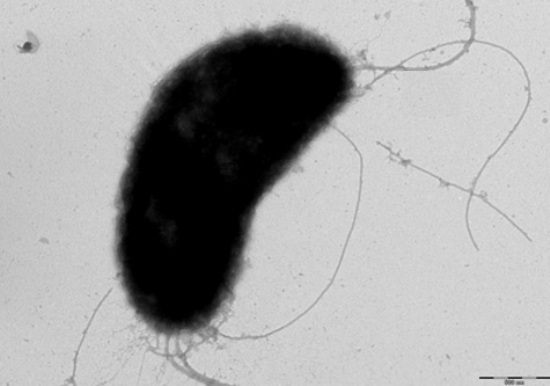Adapting To An Extreme Environment
Vibrio salmonicida is
very intriguing for a bacterium. From the way they infect their
hosts, to how they travel from host to host, this species has many functional adaptations.
Vibrio salmonicida is a bacterium found only in marine
environments. It is Gram-negative and rod-shaped. Interestingly, it is
motile and can have up to nine polar flagella (Bjelland et al. 2012 b). The
flagella play a vital role in the success and transmission of
Cold-water Vibrosis. Studies indicate that in order to be
transmitted from host to host, Vibrio salmonicida must have
functioning flagella. The main function of the flagella is to
transport the bacteria into an environment that it can rapidly
multiply in. Interestingly, once the host is infected, flagella
increases the rate of disease spread. However, flagella is not necessary for infection
to lead to death of the host. In some cases the presence of it can
actually decrease infection because the flagella is a common site
for the fishes immune system to attack the bacteria (Bjelland et al. 2012 b).
Another very important and interesting adaptation is Vibrio
salmonicida’s ability to monitor the density of itself in the
blood of its host and then regulate its production to ensure fatal
infection (Bjelland et al. 2012 b). This phenomenon is referred to as
"quorum sensing" and is seen in many other organisms as well. Quorum sensing
in Vibrio salmonicida affects the LitR gene and its
expression and link to infection. LitR is a gene that is thought to
increase the production of this bacterium. When the bacteria cell
density is high enough, the mRNA for LitR is thought to be stabilized,
causing LitR to be produced and thus more bacteria produced as well
(Bjelland et al. 2012 b). Research has shown that cells with a negative
LitR mutation have decreased host mortality rates. This same study showed that
virulence increased at higher salt concentrations and warmer
temperatures (Bjelland et al. 2012 b).
The three closest relatives of Vibrio salmonicida are
Vibrio fischeri, Vibrio logei, and Vibrio wodanis, and
these all
show bioluminescent characteristics in natural habitats. Studies
have shown that although Vibrio salmonicida does not show
these properties in nature, they do have the genes to do so, and
under certain conditions within a lab can be bioluminescent
(Fidopiastis 1998). Though Vibrio salmonicida can be
bioluminescent, it is not necessary for its life cycle (Bjelland et
al. 2012
b).
It is obvious that Vibrio salmonicida
has made several adaptations for its environment. Interestingly, this
is the only environment that this bacteria is found in. Without a
high salinity and low temperature, Vibrio salmonicida does
not survive. To this date it is unknown exactly
how Vibrio salmonicida
functions in regards to its ability to survive in this extreme
environment and how it infects its host. Much research
is being conducted within these topics because of the interesting
nature of this bacteria.
Learn more about Vibrio salmonicida's Reproduction or go to the Home Page.
See References.
